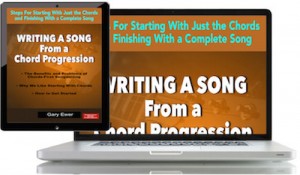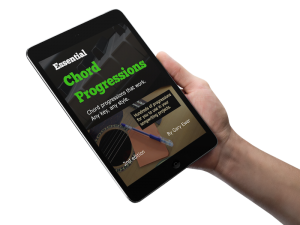If you’re a chords-first songwriter, sometimes all you’re really needing are some chord progression suggestions that you can experiment with. Once you’ve got chords that you like, it frees you up to move to other more important aspects of a song, like lyrics and melody.
 If you like the chords-first songwriting process, you’ll want to be sure to avoid some common problems that can arise. “Writing a Song From a Chord Progression” shows you how to make the most of the chords-first method of songwriting.
If you like the chords-first songwriting process, you’ll want to be sure to avoid some common problems that can arise. “Writing a Song From a Chord Progression” shows you how to make the most of the chords-first method of songwriting.
What follows is a set of chord progressions you might want to try. Every song is different, so I’ve chosen a set of progressions that follow a relatively common outline: a minor verse that moves to a major chorus, followed by a bridge section that explores other closely related keys:

These are just suggestions, and hopefully as you pick and choose which progressions you’d like to experiment with, you’ll get the strong idea of how this works so that you can create your own. But feel free to use these or modify them. Chord progressions aren’t protected by copyright, so use them however you’d like.
To start, simply choose a verse progression, then make a random choice for what chorus progression could follow, and do the same for the bridge. The progressions below are all in C major/A minor, but of course you can transpose them to any key.
Start by playing each chord for two beats. You’ll notice that most of these progressions fall under the “strong” category, tonally-speaking. So if you hear one that you like, try making modifications that might suit your own songwriting ideas.
VERSE PROGRESSION EXAMPLES
All verse progressions can be repeated until ready to move on to the chorus.
- Am Dm Bdim E7 | F C Dm E7 (last time use G7 instead of E7) (vi ii vii V7/vi | IV I ii V7/vi)
- Am G F G | Am Dm Am G (vi V IV V | vi ii vi V)
- Am F Dm E7 | Am F Dm G (vi IV ii V7/vi | vi IV ii V)
- Am C Dm Em | Am G F G (vi I ii iii | vi V IV V)
- Am Em Am Dm | C F E7sus4 E7 (vi iii vi ii | I IV V7-4/vi V7/vi)
CHORUS PROGRESSION EXAMPLES
- C F Dm G7 | Am Em F G (I IV ii V7 | vi iii IV V)
- C G Am F | C Dm F G (I V vi IV | I ii IV V)
- C Am F Dm | C G Am G (I vi IV ii | I V vi V)
- C Dm C F | C Dm Am G (I ii I IV | I ii vi V)
- C Bb C F | Bb G F G (I bVII I IV | bVII V IV V)
BRIDGE PROGRESSION EXAMPLES
- Am Em F G | Am Bb F Dm |Em Am G Dm | C F Gsus4 G (vi iii IV V | vi bVII IV ii | iii vi V ii | I IV V4 V)
- Am G Am Dm |Eb Bb Cm F | G C G F | C Dm Am G (vi V vi ii | bIII bVII i IV | V I V IV | I ii vi V)
- Dm Em Am G | Am G Dm Em | Am G/B C F | Dm Am F G (ii iii vi V | vi V ii iii | vi V6 I IV | ii vi IV V)
- Em F Em F | C Dm Em G | Am F Em F | C Dm F G (iii IV iii IV | I ii iii V | vi IV iii IV |I ii IV V)
- G Am F Em | Am G C F | G Am F Em | F C F G (V vi IV iii | vi V I IV | V vi IV iii | IV I IV V)
You’ll notice that the bridge progressions focus mainly on the relative minor of the chorus key, as that’s probably the most common relationship you’ll see. But feel free to try others. For example, a chorus in C major followed by a verse in D minor can sound great.
Randomly choosing any progression ( for example, #3 for the verse section, # 2 for the chorus, and #4 for the bridge) should work just fine. And if you end up by changing any or all of the progressions to something more suited to your song ideas, that’s the perfect use of this set of progressions. Let your imagination and your ear be your guide.
 Written by Gary Ewer. Follow Gary on Twitter.
Written by Gary Ewer. Follow Gary on Twitter.
 Sometimes all you need are lists of chords to get the songwriting process started. The Essential Secrets of Songwriting 10-eBook Bundle includes “Essential Chord Progressions” and “More Essential Chord Progressions.” Use the suggested chords as is, or modify them to suit your own songwriting project.
Sometimes all you need are lists of chords to get the songwriting process started. The Essential Secrets of Songwriting 10-eBook Bundle includes “Essential Chord Progressions” and “More Essential Chord Progressions.” Use the suggested chords as is, or modify them to suit your own songwriting project.










